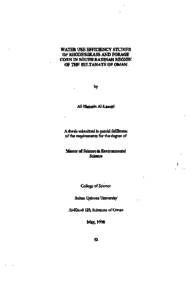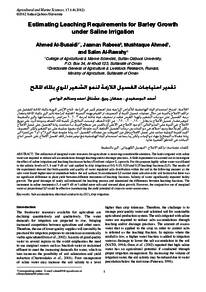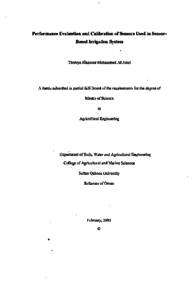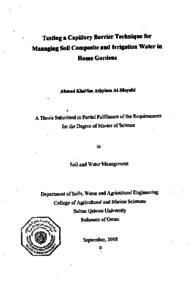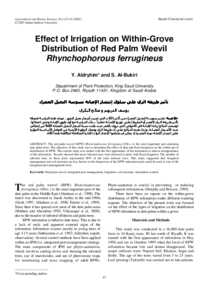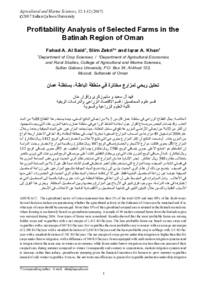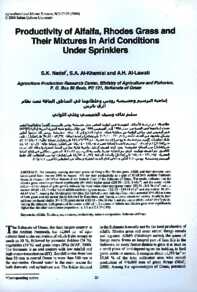Document
Water use efficiency studies of rhodesgrass and forage corn in south Batinah region of the Sultanate of Oman
Publisher
Sultan Qaboos University
Gregorian
1998
Language
English
Subject
English abstract
Agriculture accounts for 90 to 98 percent of total groundwater demand in Al-Batinah region. The demand for groundwater is much higher than the natural recharge. Low natural recharge is due to the aridity of Oman. High water demand is due to two main reasons; inefficiency of irrigation, and a cropping system characterized by a high proportion of perennial cropping area. Crop-water requirements of perennial crops are high because of their continuous year-round growth. Most of the perennial crops in Oman are forages such as alfalfa and rhodesgrass. High demand for groundwater with low natural recharge has disturbed the groundwater balance in Al-Batinah. This study attempted to find partial solutions to increase on-farm-efficiency of water use. A comparison was carried out between rhodesgrass and local forage com to determine water-use efficiency and nutritive value. In addition, the study attempted to identify factors influencing farmers' adoption of decisions for annual forage crops in south Batinah. Field studies commenced in November 1996 and concluded in June 1997. Crop-water requirement and dry matter production of two varieties of local forage corn and rhodesgrass were recorded. The experiment was carried out at the Agricultural Experimental Station at Sultan Qaboos University and at a local farm at Rumais. Forage quality analysis as determined by analyzing crude protein, crude fiber, total non-structural carbohydrates, acid detergent fiber (ADF) and neutral detergent fiber (NDF). Fifty farmers from south Al Batinah were interviewed in June 1997. The results revealed that dry matter production (DM) and water-use efficiency (WUE) of forage com (DM was 1.539 kg m/2 cuts and WUE was 2.237 kg mo) was higher than rhodesgrass (DM was 0.995 kg m and WUE was 0.913 kg m). The nutritive value results indicated that forage corn is more nutritious than rhodesgrass, since TNC values were 79.6 and 31.2 g kg* for forage corn and rhodesgrass respectively. Crude fiber (CF), NDF and ADF were 211.9, 467.01 and 274.46 g kg2 and 280.4, 619.00 and 345.74 g kg for forage corn and rhodesgrass respectively. Factors that positively influence farmers' attitude on adopting annual forage crops include the existence of off-farm income, adequate soil, and younger farmers when they have appropriate experience in farming.
Description
Thesis
Member of
Resource URL
Arabic abstract
تمثل الزراعة ما بين 90 إلى 98 في المائة من إجمالي الطلب على المياه الجوفية في منطقة الباطنة. الطلب على المياه الجوفية أعلى بكثير من التغذية الطبيعية. انخفاض التغذية الطبيعية بسبب جفاف عمان. يرجع ارتفاع الطلب على المياه إلى سببين رئيسيين ؛ عدم كفاءة الري ، ونظام زراعة المحاصيل التي تتميز بنسبة عالية من مساحة المحاصيل المعمرة. تعد احتياجات المحاصيل الدائمة من المياه مرتفعة بسبب نموها المستمر على مدار السنة. معظم المحاصيل المعمرة في عمان هي علف مثل البرسيم ورودسجراس. أدى ارتفاع الطلب على المياه الجوفية مع انخفاض التغذية الطبيعية إلى إزعاج توازن المياه الجوفية في الباطنة. حاولت هذه الدراسة إيجاد حلول جزئية لزيادة كفاءة استخدام المياه على مستوى المزرعة. وأجريت مقارنة بين الروديسغراس وكوم العلف المحلي لتحديد كفاءة استخدام المياه والقيمة الغذائية. بالإضافة إلى ذلك ، حاولت الدراسة تحديد العوامل التي تؤثر على اعتماد المزارعين لقرارات لمحاصيل الأعلاف السنوية في جنوب الباطنة. بدأت الدراسات الميدانية في نوفمبر 1996 وانتهت في يونيو 1997. تم تسجيل الاحتياجات من المياه وإنتاج المادة الجافة من صنفين من الذرة العلفية والقشريات. تم إجراء التجربة في محطة التجارب الزراعية بجامعة السلطان قابوس وفي مزرعة محلية في الرميس. تحليل جودة العلف على النحو المحدد من خلال تحليل البروتين الخام والألياف الخام والكربوهيدرات غير الهيكلية الكلية وألياف المنظفات الحمضية (ADF) وألياف المنظفات المحايدة (NDF). أجريت مقابلات مع خمسين مزارعًا من جنوب الباطنة في يونيو 1997. كشفت النتائج أن إنتاج المواد الجافة (DM) وكفاءة استخدام المياه (WUE) من العلف (كان DM يبلغ 1.539 كجم م / 2 و WUE 2.237 كجم) أعلى من الروديسجراس (كان DM 0.995 كجم م و WUE 0.913 كجم م). أشارت نتائج القيمة الغذائية إلى أن الذرة العلفية مغذية أكثر من الروديس جراس ، لأن قيم TNC كانت 79.6 و 31.2 جم كجم * بالنسبة إلى الذرة العلفية ورودسغراس على التوالي. كانت الألياف الخام (CF) و NDF و ADF هي 211.9 و 467.01 و 274.46 جم كجم 2 و 280.4 و 619.00 و 345.74 جم لكل كيلوغرام من الذرة العلفية والقشريات على التوالي. تشمل العوامل التي تؤثر إيجابيا على موقف المزارعين من تبني محاصيل العلف السنوية وجود دخل خارج المزرعة وتربة كافية ومزارعين أصغر سنا عندما يكون لديهم خبرة مناسبة في الزراعة.
Category
Theses and Dissertations

